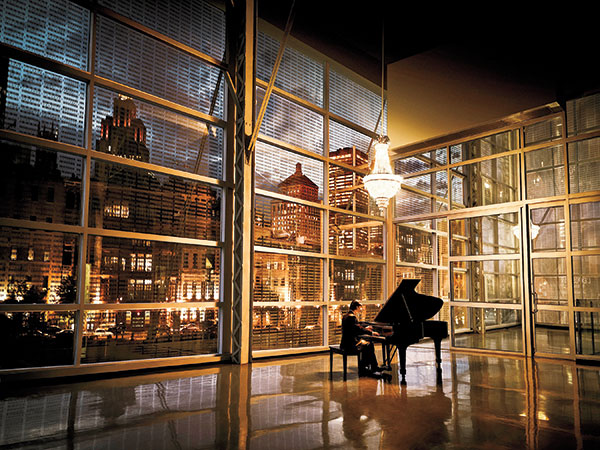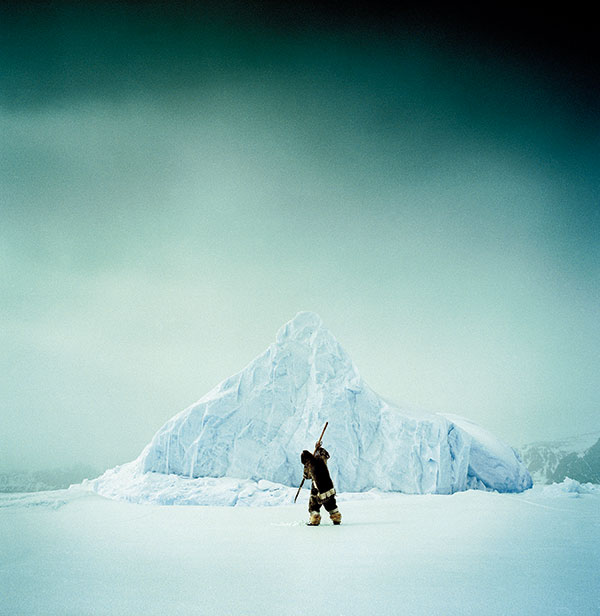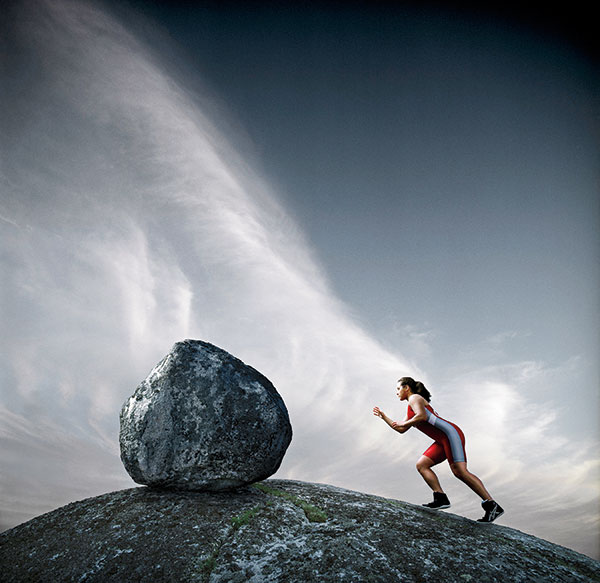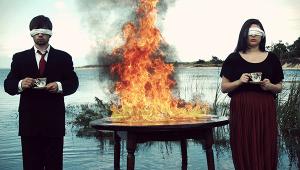Pro's Choice: The Light Touch of Peter Leverman: Photographer Takes Shooting In Available Light To The Next Level

“I had an extraordinary level of creative freedom in this advertising campaign. Here we’re promoting the client’s support for an international piano competition, featuring one of the talented contestants. Shooting in a space we’d rented, we brought in the Steinway and chandelier, and shot at dusk against the Montreal skyline.” Leverman fashioned a Fresnel hot light and large Octabank (both at camera right) so they transparently augmented the existing light. In post, he moved a couple of the buildings around in the background to make the arrangement more pleasing to the eye and extended the windows higher than they were. (Creative Director: Joe Hospodarec; Art Director: Monique Gamache; Agency: Wax.)
All Photos © Peter Leverman
“I usually try to make the scene look and feel as natural as possible while still augmenting the available light,” Canadian-born photographer Peter Leverman observes. “I want the viewer to see the image and get what I’m trying to put across without the technique getting in the way.” By extension, Leverman knows when to leave well enough alone and simply use the existing lighting, in contrast to some photographers who prefer to noticeably overwhelm the scene with their lights.
While a Kodak Instamatic first ignited his passion for photography, the road leading to this point for Leverman took firm root with a 35mm Edixa that his father gave him. The Edixa had a nonfunctioning light meter, which forced Leverman to gain a fuller understanding of light and exposure on his own. “I became very good at observing and reading light levels.” Now equipped with Nikon gear, Leverman joined a camera club in his native Nova Scotia, where more experienced photographers continued to influence his appreciation of shooting in natural light settings.

This is part of the same campaign, although here the focus is on the client’s support for a professional theater school. For this stage rehearsal, Leverman employed a combination of real students and hired talent. He lit the scene with a large Fresnel with barn doors and a Mole-Richardson bank, both rented and also serving as stage props, augmenting that with a house spotlight. Unseen, an additional Fresnel is skimming the talent from camera left, at a low level, as a subtle fill. A hazer (an environmentally friendly fog machine) added atmosphere. (Creative Director: Joe Hospodarec; Art Director: Monique Gamache; Agency: Wax.)

The ad is aimed at well-to-do individuals nearing retirement age, and is suggestive of ways to slow down and sustain a nice lifestyle without worrying about their financial future. While both the setting (a rented home) and lighting appear natural, practically every element was added (rented furnishings, props, including some vintage cameras) to give the hired talent a sense of belonging. The late afternoon sunlight came from a large Fresnel outside the window. Additional lights were bounced into the ceiling, with key lighting from a beauty dish on a Profoto head at camera left. Foamcore flats added fill. (Creative Director: Clay James; Design Director: Jason Skinner; Agency: The Buntin Group.)
Growing His Craft
As his love of photography grew, Leverman decided to attend Brooks Institute in Santa Barbara, at which point he bought a 4x5 Linhof, followed by a Hasselblad 500C, which became his go-to camera. He was also doing his own darkroom work at the time. After one year, Leverman realized that Brooks wasn’t cutting it for him, so he transferred to the Art Center College of Design in Pasadena.
Leverman assisted other photographers while at school and after graduating, but soon returned to Canada to open his own studio in Toronto. He worked there for 12 years, primarily shooting advertising. “It got to the point where I was shooting a variety of US and international jobs, more and more on location, and felt I could move back to Halifax and still do the quality of work I strive to achieve for my clients.”

“This elderly couple had been living a quiet, homespun lifestyle—and then, one day, they won millions in a lottery, all of which they gave to various charities. The wife had had cancer, and their entire lives were spent caring for each other. And that appealed to me as a genuine love story. But they were very reluctant to be photographed. I wanted the image to reflect what they were about and what they meant to one another. And I felt that the Polaroid treatment gave the viewer a gauzy detachment, so it doesn’t feel as if you’re intruding on their space and their moment.” Leverman produced this image on Type 59 Polaroid 4x5, peeling the film apart so as to retain some of the adhesive around the edges, which served as a frame. He shot this on their property, in rural Nova Scotia, by available light. (Photo Editor: Florence Nash.)
The Move To Digital
“I was reluctant to switch to digital,” Leverman admits. “I liked the tonality, warmth, and feel of film, but the market preferred digital. I would still shoot film when I could, but that was becoming less and less frequent.” The transition to digital, back in the mid-2000s, was slow, beginning with drum scans of film. “As the technology moved along and as I became more familiar with it, I grew to embrace digital fully.”
These days, Leverman prefers working with his Nikon D800 digital SLR system, calling on an arsenal of Nikon glass that primarily includes the 50mm f/1.8, 85mm f/1.8, and 16-35mm f/4. “But if the job calls for it, and depending on where I’m working, I’ll shoot Hasselblad, which I rent.” Leverman mostly works with the camera mounted to a tripod. That’s usually a Gitzo carbon fiber with an Acratech ball head.

“In rural Newfoundland it’s very common to see people hanging clothes on the line along the coast. And we felt this idyllic, innocent scene is what Newfoundland is all about.” Working with available light and locals, Leverman photographed the little girls running with a little bit of motion blur (each in a separate frame that was later composited) so that the focus would be on the grandmother hanging clothes. (Art Director: Tom Murphy; Agency: Target Marketing.)
Lighting And Location
“When I can plug in, I use Dynalites,” Leverman remarks, “but I also have a Hensel Porty battery-powered system that I often use on location.” Profoto rentals may also enter the picture. “Generally, when shooting locally, I use my own gear, although I’ll also turn to HMI and hot lights that I rent at shops catering to our growing film industry.
“We use just about everything: umbrellas, softboxes, Octabanks. Just depends on what I’m doing, where I’m doing it. I don’t tend to repeat myself much with lighting. I want the client to feel the image and not think about the lighting or any other aspect of producing it. I find myself having a stronger connection and reaction to images that feel more authentic, that appear more believable and natural.”
To handle the complexity of location jobs, “I’ll hire a producer and we’ll put a whole crew together,” Leverman notes. “I work with producers who are very familiar with the area where we plan to shoot. We almost always use location scouts, but if at all possible I scout locations myself. There’s nothing like being on the ground, framing things with your eye, being at the location at the right time of day.”

The client wanted to use iconic images reflecting endurance, integrity, and authenticity in an ad campaign for winter underwear. “For this shot, we flew up to Baffin Island, after scouting located this embedded iceberg that we used as the backdrop.” The scene would involve a native Inuit (not actually) harpooning seals in a hole in the ice. They went to great lengths to acquire a traditional Inuit harpoon to replace the modern ones in use. As they were shooting, fog and mist were rising from the mountains, while the sun dipped in and out of the clouds, resulting in wild temperatures swings. “And it all made for a moody light.” (Art Director: Neil McCulloch; Agency: SGCI.)
Connecting With The Talent
“My preference is to shoot untethered. I give the client plenty of opportunity for feedback, but at intervals, so as not to interrupt the flow of the shoot. I need to be able to connect directly with the talent and have that person focused on what I want him to do.”
How does Leverman develop rapport with his subjects? “I don’t put talent or celebrities on a pedestal. I like to have a conversation with them privately and explain what I’m trying to do and how I work. I’m not the fastest shooter and I don’t shoot a lot of images, instead taking my cues from the talent when the moment—facial expression, body attitude, movement—aligns with my vision for the shot. I try not to overshoot to the point where the talent becomes either detached or bored.”

The client has a support program for sports, in this case to fund potential Olympic athletes. Leverman photographed this young female wrestler ascending a huge boulder, confronting the smaller boulder, which represents the many obstacles a young female athlete faces in that sport. In this instance, because he was shooting after sunset, Leverman expected the lighting to look engineered. He blasted an Octabank (with a Hensel Porty inside) at the scene, first shooting her, then relocating all of his gear for the small boulder, which stood 200 yards away, shooting that separately and compositing it into the final shot. He shot the sky separately on the same night, but a little earlier, adding that final element into the finished composite. (Creative Director: Matthew Allan; Agency: Revolve.)
On Digital Retouching And Compositing
“It used to be that the agency would often take the image and do the finishing work,” Leverman points out. “These days I almost always handle the retouching. Art directors want my vision all the way through to the end.
“Mark Tyler is my go-to retoucher for the majority of assignments. We work on the images back and forth, but ultimately I’m responsible for the overall direction, treatment, and look of the shot.”
In closing, Leverman notes: “The technical side of things is important, but it’s nowhere near as important as the image. If you look back at great images from 40, 60, or 80 years ago, they were not necessarily technically impressive—but they made for wonderful pictures!”

You never know where you’ll find inspiration or talent for your next project. Leverman happened to meet this gentleman working at a hardware store in Halifax, Nova Scotia. “He’s not a real fisherman, but he had a great presence and look for a personal project I had in mind.” The lobster traps, oars, salmon he’s holding are all props, although the fish are real, purchased locally. Leverman used a Hensel Porty with a grid (upper right) to emphasize the strength and grit of our fisherman against a setting sun at camera left. “I like the idea of celebrating hard-working, unsung, regular people. Even though he may not be a salmon fisherman, he’s the real deal.”
To see more of Peter Leverman’s work, visit www.peterleverman.com.
- Log in or register to post comments

















































